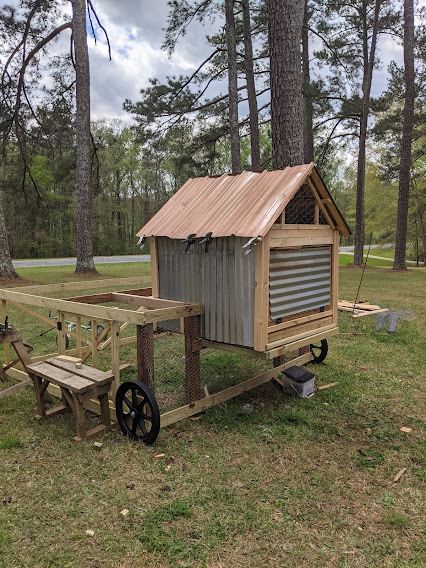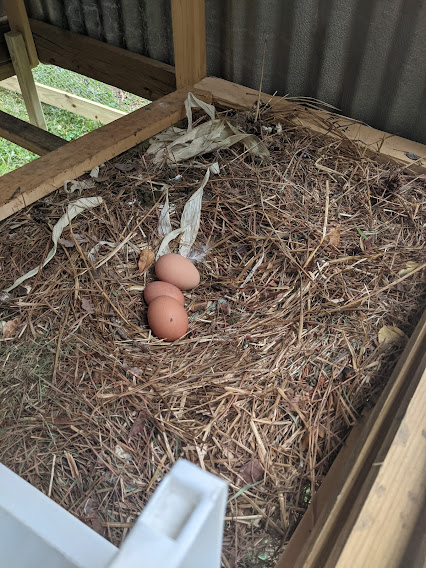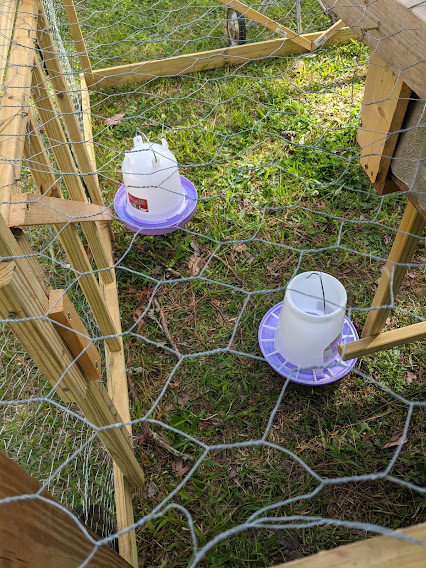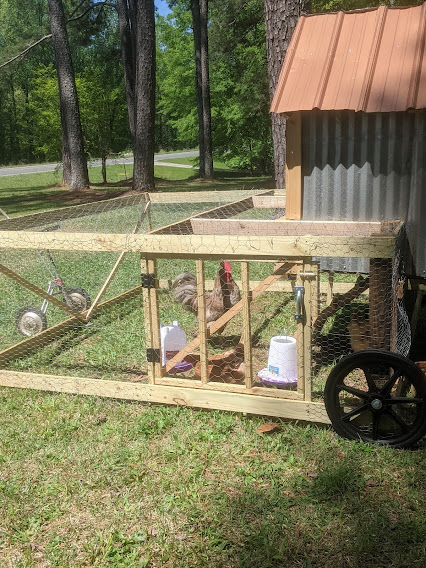We’re at the two week mark and are ready to talk about the Benefits of a Chicken Tractor. We built this as a conversation piece and experiment at the Firefly. This is part of our practice of “human scale living” and it has been long enough for us to get some early feedback from the customers, that is, the chickens.
The chicken tractor benefits for us are four: Flock harmony, egg productivity, cleanliness and chicken engagement. This has been a pretty successful idea when we actually tried it.

What is a Chicken Tractor?
If you’re still asking this, you must have somehow missed our first article on this topic. We can’t have that, can we?
So after driving this thing around for a few days we have the following updates for you as to how this is going. I’ve also linked a few other blogs on this topic at the bottom, but we have a couple of other things to say now that we’ve actually tried it.
There is Flock Harmony
We have the bulk of the flock still stuck in the big chicken coop (about 600 square feet) which is in the backyard. The flock size is about 20 chickens, of which there are three roosters. With the flock penned up together there was a constant commotion. The chickens themselves were constantly pecking each other to figure out the pecking order. The roosters were always getting into skirmishes. There was always one victim chicken that was getting pecked at.
In the Chicken Tractor we introduced one rooster and four hens, in a total of 64 square feet, and it immediately became a serene work group. There was a lot of cooing, and the crew spends their time scratching and laying, which is their job.
Since he no longer needs to to vent energy fighting his rivals, the rooster can work on taking care of fertilizing the eggs, which he does. There are no victims yet because the hens are evenly matched enough. We further guess that the hens have better things to do than fight, since there is fresh scratching every day or two.

Egg Productivity is Better
The egg count has been on average 3 eggs per day for this work group of 4 hens. Last weekend we got 9 eggs in 3 days. The rest of the flock, about 15 chickens that are stuck in the coop gave us about that same number.
Yes, that’s 18 eggs in three days. Anyone that comes to the house gets some eggs.
Who knew that a stable chicken society without a lot of scrimmaging going on would be more productive?
PS: To the actual chicken people reading this. Yes, we know that chicken laying patterns vary throughout the year. We also know that It takes 24 to 26 hours for the hen to generate her next egg. We also know that the chicken egg cycle varies depending on temperature, humidity, and other factors. Some articles are linked below.
But the little experiment of tractor vs. coop in this short time period has been very interesting.

The Garden and Porch are Chicken-free
The annual joke at this place is buying some tomato plants for the garden, and then watching the escapees from the coop gnaw on them. Thus far there have been no escapees, and no garden damage. The second annual joke is that when they were running loose, they tended to “soil” the front porch and a few other areas with a mess.
Yes it’s true that we could have been more disciplined about cooping them up, but they like foraging as part of their daily stuff, and the chicken tractor makes this a more controlled activity.
There is greater Chicken Engagement
We have this thing rolling around our big front yard, and curious visitors, of which there are a lot, can engage with the chickens. Also, whoever goes out to move the coop has a chance to check what is going on with the flock, and make any corrections. We’re still supplying food and water, and since there is a smaller work group it is easier to spot any issues.
Plus we can see and hear them from the big front porch and that is a conversation starter as well. Conversations and stories are part of our product.
Chicken engagement is one of the reasons for having them in the first place. Yes, it is a little more effort, because you can’t ignore them.

They are nearly Odor-free
Well, these guys were spread out enough in our fixed coop that odor was not much of a thing anyway. Also, we’re literally 400 yards from a small sized commercial chicken operation. If there is any stink it’s because of them.
But thus far this has been a tidy, odor free operation since there is no chance for a mess to accumulate. Note: We’ve made the floor of the nesting box out of wire, so any real nastiness drops directly onto the ground. We’ve yet to have or need the first cleaning.
PS the other benefit of the elevated nesting box is that you can drive a wheelbarrow under the door and catch the fun stuff.
There are no predators (yet)
We only had predators in the main coop a few times, the worst offenders were the dogs. But they seem to leave this place alone so far. The main coop is in a fixed location, with a lot of bushes and trees surrounding it. Easy for something to sneak in.
It’s much harder out in the middle of an open space to be stealthy.
According to the source below, rats avoid these things for this very reason. There is no easy way to sneak out into the middle of this big open space without the local owl or hawk spotting it.
We put a wire roof on it too, so the hawks and buzzards won’t mess with the inhabitants either

Design Issues
A couple of things, just in case you’re interested in the design:
The method of moving it is to stick a golf cart buggy under the front board. You lever it up, and pull it using the golf buggy wheels. This works brilliantly except that it puts stress on the front board. We’re going to have to redistribute the force somehow. This can be connecting the front to the sides or back by either a cable or some other means. But, that is not a big engineering problem.
The second issue is that the wheels do tend to sink into the grass a bit. We’ve had plenty of rain this year and if we had to do it again, some boat dock wheels or similar might have been a better choice because they are wider. But, they would have been less easy to wheel around, so for now we’re leaving them.
One of the great things about this design is that it is essentially weightless. Since half of the weight of the nesting box is behind the wheels, it’s no problem for any of the crew to move this thing.
There were a couple of comments questioning the box being elevated two feet off of the ground. The benefit to that at the moment is that you don’t need to bend over to inspect the nest. You open the front door, and the eggs are right in front of you.
Sometimes they need feed or water, and the little feeder and waterer take cares of that. Other than that, you don’t have to bend over to take care of them. Back ergonomics for the human is important.
Drawbacks (So Far)
Well, the chickens do like to take dust baths, and if they don’t have any dust, they’ll dig into the ground to find some. So, there are a few chicken holes. That seems like a minimal drawback, and if there’s a problem we will figure out how to deal with it.
A portable dust box, attached to the top or sides somehow is not out of the question.
The second one is that it is still a little work, there’s no such thing as ignoring them because if you do, they’ll skin the grass all the way to zero, and you don’t want that.
We still like the lawn in a way.
The Final Outcome: Benefits of the Chicken Tractor
The chicken tractor benefits, which are flock harmony, egg productivity, cleanliness and chicken engagement have made this a pretty successful idea.
Are there cheaper and better ways to do this? Possibly. We still have 15 or so chickens in the coop, there are plenty of design options, and more chances to experiment.
Could we become a model chicken tractor experiment place? If you want to click “book now” and reserve a week or two to build chicken tractors and drive them around the yard, we will by all means let you. We like people who do things.
Links and References
https://animals.mom.com/number-eggs-given-chicken-its-life-cycle-9646.html
![]()
